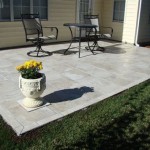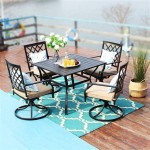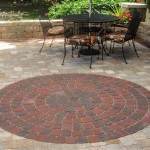What Size Patio Umbrella for a 6-Person Table?
Determining the appropriate size of a patio umbrella for a 6-person table is crucial for ensuring adequate shade and comfort for all individuals seated around the table. Too small an umbrella will leave some people exposed to the sun, while an excessively large umbrella can appear disproportionate and may not be suitable for the available space. A properly sized umbrella will enhance the functionality and aesthetic appeal of the outdoor dining area.
The primary purpose of a patio umbrella is to provide shade, protecting individuals from harmful UV rays and direct sunlight. This protection allows for a more comfortable and enjoyable outdoor dining experience. Furthermore, a well-chosen umbrella can contribute to the overall ambiance of the patio, complementing the existing furniture and landscape. Selecting the correct size requires considering several factors, including the table's dimensions, the desired level of shade coverage, and the surrounding environment.
The following sections will explore these factors in detail, providing a comprehensive guide to choosing the ideal patio umbrella size for a 6-person table.
Understanding Table Dimensions and Shade Coverage
The dimensions of the 6-person table are the foundational element in determining the appropriate umbrella size. While “6-person table” is a common descriptor, the actual dimensions can vary significantly depending on the table's shape (round, rectangular, or oval) and specific design. A general guideline suggests that a 6-person table typically ranges from 60 to 72 inches in length for rectangular tables, and 48 to 60 inches in diameter for round tables. It is imperative to accurately measure the table's dimensions before selecting an umbrella.
Once the table dimensions are known, the desired shade coverage can be determined. Ideally, the umbrella should extend at least 2 feet beyond the edge of the table on all sides. This extension ensures that those seated around the table are adequately protected from the sun, even as its angle shifts throughout the day. For a rectangular table that is 60 inches long and 36 inches wide, the umbrella should ideally have a diameter or length of at least 84 inches (7 feet) to provide the desired overhang. Similarly, for a round table with a 48-inch diameter, an umbrella with a diameter of at least 72 inches (6 feet) would be recommended.
However, these are merely guidelines. The specific needs of the individuals using the table should also be considered. For example, in areas with intense sunlight, a larger overhang may be necessary to provide sufficient shade. Conversely, in areas with less intense sunlight, a slightly smaller umbrella may suffice.
Beyond the table size, the location of the table in relation to the sun's path is relevant. If the table is positioned in a location where it receives direct sunlight throughout the day, a larger umbrella with a greater degree of tilt functionality may be beneficial. Tilt functionality allows the umbrella to be adjusted to effectively block the sun as it moves across the sky. Without tilt functionality, the umbrella may only provide adequate shade during certain times of the day.
Different umbrella shapes can also affect shade coverage. While round umbrellas are a common choice, square or rectangular umbrellas may provide better coverage for rectangular tables, as they more closely match the table's shape. This can minimize wasted space and ensure more consistent shade distribution. Octagonal umbrellas offer a compromise, providing a more aesthetically pleasing shape while still offering substantial shade coverage.
Ultimately, accurately measuring the table and carefully considering the desired shade coverage are crucial steps in selecting the appropriate umbrella size. These factors will ensure that the umbrella effectively protects individuals from the sun and enhances the overall outdoor dining experience.
Considering Umbrella Shape, Features, and Base
The shape of the patio umbrella plays a significant role in both its aesthetic appeal and its effectiveness in providing shade. Common shapes include round, square, rectangular, and octagonal. Round umbrellas are generally the most popular choice, offering a classic and versatile look that complements various outdoor settings. Square and rectangular umbrellas, as mentioned previously, often provide more efficient shade coverage for rectangular tables, minimizing gaps and maximizing protection from the sun.
Octagonal umbrellas offer a blend of aesthetic appeal and functionality. Their multi-sided shape provides ample shade coverage while maintaining a visually appealing form. The choice of shape ultimately depends on personal preference and the specific dimensions of the table. However, it is important to consider how the shape of the umbrella will interact with the table and the surrounding environment.
Beyond shape, specific umbrella features can enhance both functionality and convenience. Tilt functionality, as discussed earlier, is highly desirable, allowing the umbrella to be adjusted to block the sun from different angles. Crank lift mechanisms provide an easy and smooth way to open and close the umbrella, while push-button tilt mechanisms offer a simpler, more cost-effective option. Some umbrellas also feature vents at the top, which allow air to circulate, reducing the risk of the umbrella being caught by the wind. Vents also help to prevent the umbrella from inverting during windy conditions.
The material of the umbrella canopy is another important consideration. Polyester fabrics are a common and affordable choice, offering decent UV protection and water resistance. Olefin fabrics are more durable and fade-resistant, making them a better option for areas with intense sunlight. Acrylic fabrics, such as Sunbrella, are the most premium option, offering superior UV protection, water resistance, and longevity. The choice of fabric will impact the umbrella's lifespan and its ability to withstand the elements.
Equally important is the umbrella base. A sturdy and properly weighted base is essential for keeping the umbrella stable and preventing it from tipping over, especially in windy conditions. The weight of the base should be appropriate for the size and type of umbrella. A general rule of thumb is that the base should weigh at least 50 pounds for umbrellas up to 9 feet in diameter. For larger umbrellas, a heavier base of 70 pounds or more may be necessary. Base materials include concrete, steel, cast iron, and resin. Concrete bases are durable and provide excellent stability, while steel and cast iron bases offer a more elegant and stylish look. Resin bases are lightweight and easy to move, but may not provide as much stability as heavier options.
In summary, considering the shape, features, and base of the patio umbrella is crucial for ensuring both functionality and safety. A well-chosen umbrella will not only provide adequate shade but will also enhance the overall aesthetic appeal of the outdoor dining area. The base is a critical, often overlooked, component that directly affects the umbrella's stability and resistance to wind.
Alternatives to Traditional Patio Umbrellas
While traditional center-pole patio umbrellas are a common choice, there are alternative options that may be better suited for certain situations or preferences. Cantilever umbrellas, also known as offset umbrellas, feature a side-mounted pole, allowing the canopy to be suspended over the table without a pole obstructing the seating area. This design offers greater flexibility and provides unobstructed views. Cantilever umbrellas are particularly useful for larger tables or seating areas where a center pole would be inconvenient or impractical.
Another alternative is a shade sail. Shade sails are fabric canopies that are suspended between multiple points, providing shade over a designated area. They offer a more modern and architectural look compared to traditional umbrellas. Shade sails can be customized to fit various shapes and sizes, making them a versatile option for creating shade in outdoor spaces. However, installing shade sails may require more planning and potentially the installation of support structures.
Pergolas with retractable canopies offer a more permanent and structured shade solution. Pergolas are outdoor structures typically made of wood or metal, with open frameworks that can be covered with climbing plants or a retractable canopy. Retractable canopies allow you to easily adjust the amount of shade, providing flexibility depending on the weather conditions. Pergolas can also add architectural interest to the outdoor space.
For those who prefer a more natural approach, planting trees or shrubs strategically around the patio can provide shade. This option requires more time and planning, as it takes time for trees and shrubs to grow and mature. However, it can offer long-term benefits, including natural cooling, improved air quality, and enhanced aesthetic appeal. Choosing the right species of trees and shrubs is crucial, considering their mature size, growth rate, and shade density.
Finally, consider the use of portable sunshades. These are smaller, lighter-weight solutions, such as pop-up canopies or smaller umbrellas that can be easily moved and adjusted as needed. While they might not offer the same coverage as a full-size patio umbrella, they can be useful for providing targeted shade in specific areas or for individuals who require extra protection from the sun.
The choice of alternative shade solution depends on various factors, including the desired level of permanence, the available space, the budget, and personal preferences. Each option offers unique advantages and disadvantages, and careful consideration should be given to determine the most suitable choice for the specific needs of the outdoor dining area.

The Ultimate Umbrella Size Guide You Are Looking For

Patio Umbrella Size Guide Midtownumbrellas Com

Patio Umbrella Size Guide Midtownumbrellas Com

Patio Umbrella Size Guide Midtownumbrellas Com

Patio Umbrella Size Guide Midtownumbrellas Com

The Ultimate Patio Umbrella Buyers Guide

Patio Umbrella Size Guide Midtownumbrellas Com

The Ultimate Umbrella Size Guide You Are Looking For

Patio Umbrella Size Guide Midtownumbrellas Com

The Ultimate Umbrella Size Guide You Are Looking For
Related Posts








